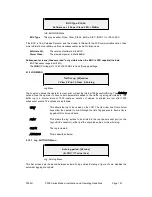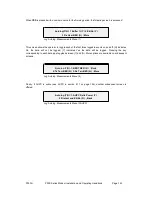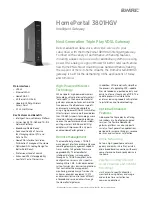
P300H
P300 Series Modem Installation and Operating Handbook
Page 107
ÞÛÎ ÛÍÌ×ÓßÌÛ
This selects the source for the USER BER estimate displayed on the Receive
Status Screens, and compared to both the Deferred USER BER alarm, and
BER > 1 x 10
-3
alarm thresholds. The selection is from:
ßËÌÑ
The unit selects the most appropriate source. Note that
the INTELSAT
mandatory method is FAW
, although
ß«¬±
will select more accurate or more
quickly updated methods if available. The list of priorities is as follows:
1.
The PRBS tester (if in the main data channel)
2.
The Reed-Solomon outer FEC Codec (if active)
3.
The Turbo, Viterbi or Sequential inner FEC (if active)
4.
The PRBS tester in ESC or Aux channels (if active)
5.
The errors counted over one minute on the
FAW
(if framed)
6.
No estimate of BER
ÚßÉ
An estimate based on the count of errors on the Frame Alignment Words
(FAW) received by the deframer over a 1 minute sliding window. Only available
if operating in a framed mode.
ÚÛÝ
An estimate of the output error rate from the FEC decoder, based on the count
of errors into the FEC and the FEC code rate. Note that if FEC is manually
selected, but Reed-Solomon is active, the BER estimate will not include the
significant error improvement of the RS codec.
ÎÍ
An estimate of the output error rate of the RS Decoder based on the number of
uncorrectable words passed by the decoder.
ÐÎÞÍ
The real BER as measured by the PRBS tester, whether it be in the ESC or
Aux
channel, or the main data channel.
Default:
ßËÌÑ
×ÞÍ ÓÚ ÐÛÎ×ÑÜ
This option is only applicable to Custom, IBS, Minimum overhead modes. In
this mode the overhead is varied to accommodate any ESC requirements, and
if the ESC and main data rate are very low the overhead multiframe structure
might be very long. Whenever the Rx carrier is re-acquired the multiframe
alignment also has to be re-acquired, and this option allows the
maximum
multiframe period to be specified in order to prevent excessively long
multiframe periods affecting carrier re-acquisition times. By default it is 2000ms,
approximately 4 times the normal IBS multiframe time of 512ms at 64kbps. This
will only be an issue where very low data rates (<16kbps) and low ESC rates
are in use, or Minimum overhead mode is active with
No
ESC requirement and
the multiframe just provides timeslot ID maintenance and backward alarm
facilities. Only consider adjusting from default if you see long periods where the
status displays "TS32 Multiframe sync lost" or "CAS Multiframe sync lost" after
the demod has lost and re-acquired the carrier.
Default:
îððð³-
Ý¿®®·»® ×ÜùÍ
The earlier versions of the Eutelsat SMS specification defined 3 eight bit
identities which may be transmitted once per satellite TS32 multiframe to
identify the carrier and the earth station. These were named
ͬ¿¬·±² ×Ü
,
Ý¿®®·»®
×Ü
&
Í°¿®» ×Ü
. More recent issues just say "reserved for uses such as.....". This
options allows these three ID's to be set (0-255 for each), and also displays the
corresponding ID's from the incoming Rx carrier.
Default: all
îëë
ÞßÝÕ ßÔÓ
ÓßÐ
In Custom IBS Modes it is possible to operate an IBS style service, and allow
the use of four independent backward alarms (as for IDR) for use on
multidestinational services. This option allows the four alarms to be mapped in
different ways onto the IBS TS32 multiframe, in the hope that should
INTELSAT adopt such a standard, the P300 Modems could be set to be
Содержание P300 Series
Страница 21: ...P300H P300 Series Modem Installation and Operating Handbook Page 21 F BLOCK DIAGRAM ...
Страница 22: ...P300H P300 Series Modem Installation and Operating Handbook Page 22 ...
Страница 163: ...P300H P300 Series Modem Installation and Operating Handbook Page 163 8 12 4 Eb No Explanatory Diagram ...
















































